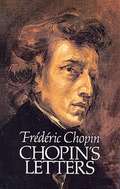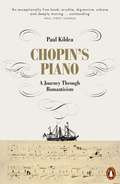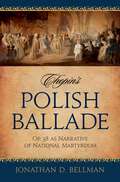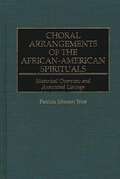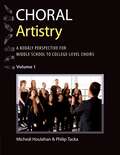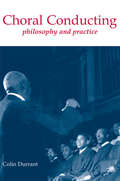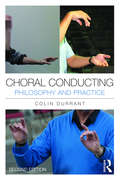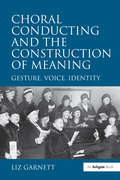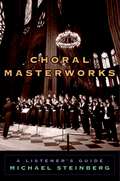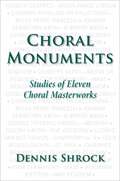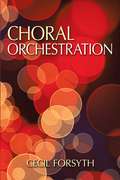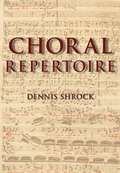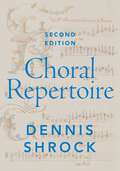- Table View
- List View
Chopin in Britain
by Peter WillisIn 1848, the penultimate year of his life, Chopin visited England and Scotland at the instigation of his aristocratic Scots pupil, Jane Stirling. In the autumn of that year, he returned to Paris. The following autumn he was dead. Despite the fascination the composer continues to hold for scholars, this brief but important period, and his previous visit to London in 1837, remain little known. In this richly illustrated study, Peter Willis draws on extensive original documentary evidence, as well as cultural artefacts, to tell the story of these two visits and to place them into aristocratic and artistic life in mid-nineteenth-century England and Scotland. In addition to filling a significant hole in our knowledge of the composer’s life, the book adds to our understanding of a number of important figures, including Jane Stirling and the painter Ary Scheffer. The social and artistic milieux of London, Manchester, Glasgow and Edinburgh are brought to vivid life.
Chopin in Britain
by Peter WillisIn 1848, the penultimate year of his life, Chopin visited England and Scotland at the instigation of his aristocratic Scots pupil, Jane Stirling. In the autumn of that year, he returned to Paris. The following autumn he was dead. Despite the fascination the composer continues to hold for scholars, this brief but important period, and his previous visit to London in 1837, remain little known. In this richly illustrated study, Peter Willis draws on extensive original documentary evidence, as well as cultural artefacts, to tell the story of these two visits and to place them into aristocratic and artistic life in mid-nineteenth-century England and Scotland. In addition to filling a significant hole in our knowledge of the composer’s life, the book adds to our understanding of a number of important figures, including Jane Stirling and the painter Ary Scheffer. The social and artistic milieux of London, Manchester, Glasgow and Edinburgh are brought to vivid life.
Chopin's Letters (Dover Books on Music)
by E. L. Voynich Frederic ChopinThis superbly edited selection of nearly 300 of Chopin's letters, the first to be published in English, vividly reveals the composer as man and artist, and evokes the remarkable age — Europe of the 1830s and 1840s — he shared with an equally remarkable cast of characters, from Jenny Lind to Isabella II of Spain, from Queen Victoria to George Sand, from Heinrich Heine to Victor Hugo. Originally collected by the Polish musicologist Henryk Opienski, the letters have been translated and annotated by Chopin scholar E. L. Voynich. Students and admirers of Chopin will find in their pages vast resources to deepen their love and appreciation for — and wonderment at — the unique individuality and achievement of this great musical personality.
Chopin's Piano: A Journey through Romanticism
by Paul KildeaIn November 1838 Frédéric Chopin, George Sand and her two children sailed to Majorca to escape the Parisian winter. They settled in an abandoned monastery at Valldemossa in the mountains above Palma, where Chopin finished what would eventually be recognised as one of the great and revolutionary works of musical Romanticism - his 24 Preludes. There was scarcely a decent piano on the island (these were still early days in the evolution of the modern instrument), so Chopin worked on a small pianino made by a local craftsman, which remained in their monastic cell for seventy years after he and Sand had left.This brilliant and unclassifiable book traces the history of Chopin's 24 Preludes through the instruments on which they were played, the pianists who interpreted them and the traditions they came to represent. Yet it begins and ends with the Majorcan pianino, which during the Second World War assumed an astonishing cultural potency as it became, for the Nazis, a symbol of the man and music they were determined to appropriate as their own.The unexpected hero of the second part of the book is the great keyboard player and musical thinker Wanda Landowska, who rescued the pianino from Valldemossa in 1913, and who would later become one of the most influential musical figures of the twentieth century. Kildea shows how her story - a compelling account based for the first time on her private papers - resonates with Chopin's, while simultaneously distilling part of the cultural and political history of Europe and the United States in the central decades of the century. Kildea's beautifully interwoven narratives, part cultural history and part detective story, take us on an unexpected journey through musical Romanticism and allow us to reflect freshly on the changing meaning of music over time.
Chopin's Polish Ballade: Op. 38 as Narrative of National Martyrdom
by Jonathan D. BellmanChopin's Polish Ballade examines the Second Ballade, Op. 38, and how that work gave voice to the Polish cultural preoccupations of the 1830s, using musical conventions from French opera and amateur piano music. This approach provides answers to several persistent questions about the work's form, programmatic content, and poetic inspiration.
Chopin's Polish Ballade: Op. 38 as Narrative of National Martyrdom
by Jonathan D. BellmanChopin's Polish Ballade examines the Second Ballade, Op. 38, and how that work gave voice to the Polish cultural preoccupations of the 1830s, using musical conventions from French opera and amateur piano music. This approach provides answers to several persistent questions about the work's form, programmatic content, and poetic inspiration.
Choral Arrangements of the African-American Spirituals: Historical Overview and Annotated Listings (Music Reference Collection)
by Patricia J. TriceAlthough the choral arrangements of the African-American spirituals constitute the largest group of folk song arrangements in western literature, they have received little scholarly attention. This book provides the needed historical and stylistic information about the spirituals and the arrangements. It traces the history and cultural roots of the genre through its inception and delineates the African and European characteristics common to the original folk songs and arrangements. Ensembles that have perpetuated the growth of the spiritual arrangements—from Fisk Jubilee Singers of the 1870s through those currently active—are chronicled as well.Musicians, choral directors, and scholars will welcome this first complete text on the African-American spiritual genre. Annotated listings of titles provide information choral directors need to make ensemble-appropriate performance choices. Arrangements indexed by title, arranger, and subject complement the accompanying biographies and repertoire information. Well-organized and thoroughly researched, this text is a valuable addition to music, choral, multicultural, and African-American libraries.
Choral Artistry: A Kodály Perspective for Middle School to College-Level Choirs, Volume 1 (Kodaly Today Handbook Series)
by Micheál Houlahan Philip TackaChoral Artistry provides a practical and organic approach to teaching choral singing and sight-reading. The text is grounded in current research from the fields of choral pedagogy, music theory, music perception and cognition. Topics include framing a choral curriculum based on the Kodály concept; launching the academic year for beginning, intermediate, and advanced choirs; building partwork skills; sight-reading; progressive music theory sequences for middle to college level choirs; teaching strategies; choral rehearsal plans as well as samples of how to teach specific repertoire from medieval to contemporary choral composers. As part of the Kodály philosophy's practical approach, authors Micheál Houlahan and Philip Tacka employ two models for learning choral literature: Performance Through Sound Analysis Pedagogy (PTSA) and Performance through Sound Analysis and Notation (PTSAN). Both models delineate an approach to teaching a choral work that significantly improves students' musicianship while engaging the ensemble in learning the overall composition in partnership with the conductor. The final chapter of the book includes rubrics to assess the effectiveness of a choral program. This book does not purport to be a comprehensive choral pedagogy text. It is a detailed guide to helping choral directors at all levels improve the choral singing and musicianship of their students from a Kodály perspective.
Choral Artistry: A Kodály Perspective for Middle School to College-Level Choirs, Volume 1 (Kodaly Today Handbook Series)
by Micheál Houlahan Philip TackaChoral Artistry provides a practical and organic approach to teaching choral singing and sight-reading. The text is grounded in current research from the fields of choral pedagogy, music theory, music perception and cognition. Topics include framing a choral curriculum based on the Kodály concept; launching the academic year for beginning, intermediate, and advanced choirs; building partwork skills; sight-reading; progressive music theory sequences for middle to college level choirs; teaching strategies; choral rehearsal plans as well as samples of how to teach specific repertoire from medieval to contemporary choral composers. As part of the Kodály philosophy's practical approach, authors Micheál Houlahan and Philip Tacka employ two models for learning choral literature: Performance Through Sound Analysis Pedagogy (PTSA) and Performance through Sound Analysis and Notation (PTSAN). Both models delineate an approach to teaching a choral work that significantly improves students' musicianship while engaging the ensemble in learning the overall composition in partnership with the conductor. The final chapter of the book includes rubrics to assess the effectiveness of a choral program. This book does not purport to be a comprehensive choral pedagogy text. It is a detailed guide to helping choral directors at all levels improve the choral singing and musicianship of their students from a Kodály perspective.
Choral Conducting: Philosophy and Practice
by Colin DurrantChoral Conducting is a resource for singers, teachers, and choral conductors, and a college-level text for students of choral conducting. It also includes an overview of what is involved in leading a choral group and examines theories of learning and human behaviour and the history of choral music together with conductor's role. The book also discusses issues of the conductor-vocalist relationship, the mechanics of singing, rehearsal strategies, and more.
Choral Conducting: Philosophy and Practice
by Colin DurrantChoral Conducting is a resource for singers, teachers, and choral conductors, and a college-level text for students of choral conducting. It also includes an overview of what is involved in leading a choral group and examines theories of learning and human behaviour and the history of choral music together with conductor's role. The book also discusses issues of the conductor-vocalist relationship, the mechanics of singing, rehearsal strategies, and more.
Choral Conducting: Philosophy and Practice
by Colin DurrantChoral Conducting: Philosophy and Practice, Second Edition is an updated resource for conductors and singers alike, a college-level text for students of choral conducting that considers conducting and singing from a holistic perspective. This singer-friendly and voice-healthy approach examines the rehearsal environment alongside its musical performance counterpart. The author explores what is involved in leading a choral group, examining theories of learning and human behavior to understand the impact choral conductors have on the act of singing. Divided into two main parts—Philosophy and Practice—the text begins with an historical look at conducting, exploring questions of why people sing and why they sing together, and ultimately presents the application of this philosophy, showing how a conductor’s gestures and patterns can influence vocal outcomes. In addressing how singers learn and respond to choral music, as well as how conductors communicate with singers in rehearsal and performance, Choral Conducting turns an eye to learning how we learn and the role successful choral conductors play in motivating singers, developing healthy singing habits, and improving individual and ensemble vocal quality—all with the aims of enhancing musical understanding. New to this edition: Updated diagrams, photos, and musical examples Revised sample choral programs Increased consideration of the orchestral conductor A renewed focus on the intersections of learning, health and well-being, and the social perspective, supported by new and recent research
Choral Conducting: Philosophy and Practice
by Colin DurrantChoral Conducting: Philosophy and Practice, Second Edition is an updated resource for conductors and singers alike, a college-level text for students of choral conducting that considers conducting and singing from a holistic perspective. This singer-friendly and voice-healthy approach examines the rehearsal environment alongside its musical performance counterpart. The author explores what is involved in leading a choral group, examining theories of learning and human behavior to understand the impact choral conductors have on the act of singing. Divided into two main parts—Philosophy and Practice—the text begins with an historical look at conducting, exploring questions of why people sing and why they sing together, and ultimately presents the application of this philosophy, showing how a conductor’s gestures and patterns can influence vocal outcomes. In addressing how singers learn and respond to choral music, as well as how conductors communicate with singers in rehearsal and performance, Choral Conducting turns an eye to learning how we learn and the role successful choral conductors play in motivating singers, developing healthy singing habits, and improving individual and ensemble vocal quality—all with the aims of enhancing musical understanding. New to this edition: Updated diagrams, photos, and musical examples Revised sample choral programs Increased consideration of the orchestral conductor A renewed focus on the intersections of learning, health and well-being, and the social perspective, supported by new and recent research
Choral Conducting and the Construction of Meaning: Gesture, Voice, Identity
by Liz GarnettIt is a truism in teaching choral conducting that the director should look like s/he wishes the choir to sound. The conductor's physical demeanour has a direct effect on how the choir sings, at a level that is largely unconscious and involuntary. It is also a matter of simple observation that different choral traditions exhibit not only different styles of vocal production and delivery, but also different gestural vocabularies which are shared not only between conductors within that tradition, but also with the singers. It is as possible to distinguish a gospel choir from a barbershop chorus or a cathedral choir by visual cues alone as it is simply by listening. But how can these forms of physical communication be explained? Do they belong to a pre-cultural realm of primate social bonding, or do they rely on the context and conventions of a particular choral culture? Is body language an inherent part of musical performance styles, or does it come afterwards, in response to music? At a practical level, to what extent can a practitioner from one tradition mandate an approach as 'good practice', and to what extent can another refuse it on the grounds that 'we don't do it that way'? This book explores these questions at both theoretical and practical levels. It examines textual and ethnographic sources, and draws on theories from critical musicology and nonverbal communication studies to analyse them. By comparing a variety of choral traditions, it investigates the extent to which the connections between conductor demeanour and choral sound operate at a general level, and in what ways they are constructed within a specific idiom. Its findings will be of interest both to those engaged in the study of music as a cultural practice, and to practitioners involved in a choral conducting context that increasingly demands fluency in a variety of styles.
Choral Conducting and the Construction of Meaning: Gesture, Voice, Identity
by Liz GarnettIt is a truism in teaching choral conducting that the director should look like s/he wishes the choir to sound. The conductor's physical demeanour has a direct effect on how the choir sings, at a level that is largely unconscious and involuntary. It is also a matter of simple observation that different choral traditions exhibit not only different styles of vocal production and delivery, but also different gestural vocabularies which are shared not only between conductors within that tradition, but also with the singers. It is as possible to distinguish a gospel choir from a barbershop chorus or a cathedral choir by visual cues alone as it is simply by listening. But how can these forms of physical communication be explained? Do they belong to a pre-cultural realm of primate social bonding, or do they rely on the context and conventions of a particular choral culture? Is body language an inherent part of musical performance styles, or does it come afterwards, in response to music? At a practical level, to what extent can a practitioner from one tradition mandate an approach as 'good practice', and to what extent can another refuse it on the grounds that 'we don't do it that way'? This book explores these questions at both theoretical and practical levels. It examines textual and ethnographic sources, and draws on theories from critical musicology and nonverbal communication studies to analyse them. By comparing a variety of choral traditions, it investigates the extent to which the connections between conductor demeanour and choral sound operate at a general level, and in what ways they are constructed within a specific idiom. Its findings will be of interest both to those engaged in the study of music as a cultural practice, and to practitioners involved in a choral conducting context that increasingly demands fluency in a variety of styles.
Choral Masterworks: A Listener's Guide
by Michael SteinbergMichael Steinberg's highly successful listener's guides--The Symphony and The Concerto--have been universally praised for their blend of captivating biography, crystal clear musical analysis, and delightful humor. Now Steinberg follows these two greatly admired volumes with Choral Masterworks, the only such guide available to this most popular of musical forms. Here are more than fifty illuminating essays on the classic choral masterworks, ranging from Handel's Messiah, Bach's Mass in B Minor, and Beethoven's Missa solemnis, to works by Haydn, Brahms, Mendelssohn, and many others. Steinberg spans the entire history of classical music, from such giants of the Romantic era as Verdi and Berlioz, to leading modern composers such as Elgar, Rachmaninoff, Vaughan Williams, and Stravinsky, to contemporary masters such as John Adams and Charles Wuorinen. For each piece, Steinberg includes a fascinating biographical account of the work's genesis, often spiced with wonderful asides. The author includes an astute musical analysis of each piece, one that casual music lovers can easily appreciate and that more serious fans will find invaluable. The book also provides basic information such as the various movements of the work, the organization of the chorus and orchestra, and brief historical notes on early performances. More than twenty million Americans perform regularly in choirs or choruses. Choral Masterworks will appeal not only to concert goers and CD collectors, but also to this vast multitude of choral performers, an especially engaged and active community. "What sets Steinberg's writing apart is its appealing mixture of impregnable authority (he knows this music) and purely personal asides (by the end of the book, we know this man). Choral Masterworks can be read by anybody, from a professional musician to any young listener newly braced by the stoic pessimism of the Brahms 'German Requiem.'" --Washington Post Book World
Choral Masterworks: A Listener's Guide
by Michael SteinbergMichael Steinberg's highly successful listener's guides--The Symphony and The Concerto--have been universally praised for their blend of captivating biography, crystal clear musical analysis, and delightful humor. Now Steinberg follows these two greatly admired volumes with Choral Masterworks, the only such guide available to this most popular of musical forms. Here are more than fifty illuminating essays on the classic choral masterworks, ranging from Handel's Messiah, Bach's Mass in B Minor, and Beethoven's Missa solemnis, to works by Haydn, Brahms, Mendelssohn, and many others. Steinberg spans the entire history of classical music, from such giants of the Romantic era as Verdi and Berlioz, to leading modern composers such as Elgar, Rachmaninoff, Vaughan Williams, and Stravinsky, to contemporary masters such as John Adams and Charles Wuorinen. For each piece, Steinberg includes a fascinating biographical account of the work's genesis, often spiced with wonderful asides. The author includes an astute musical analysis of each piece, one that casual music lovers can easily appreciate and that more serious fans will find invaluable. The book also provides basic information such as the various movements of the work, the organization of the chorus and orchestra, and brief historical notes on early performances. More than twenty million Americans perform regularly in choirs or choruses. Choral Masterworks will appeal not only to concert goers and CD collectors, but also to this vast multitude of choral performers, an especially engaged and active community. "What sets Steinberg's writing apart is its appealing mixture of impregnable authority (he knows this music) and purely personal asides (by the end of the book, we know this man). Choral Masterworks can be read by anybody, from a professional musician to any young listener newly braced by the stoic pessimism of the Brahms 'German Requiem.'" --Washington Post Book World
Choral Monuments: Studies of Eleven Choral Masterworks
by Dennis ShrockChoral Monuments provides extensive material about eleven epoch-making choral masterworks that span the history of Western culture. Included are: Missa Pange lingua (Josquin Desprez); Missa Papae Marcelli (G. P. da Palestrina); B Minor Mass (J. S. Bach); Messiah (G. F. Handel); The Creation (Joseph Haydn); Symphony #9 (Ludwig van Beethoven); St. Paul (Felix Mendelssohn); Ein deutsches Requiem (Johannes Brahms); Messa da Requiem (Giuseppe Verdi); Mass (Igor Stravinsky); and War Requiem (Benjamin Britten). The works are presented in separate chapters, with each chapter divided into three basic sections-history, analysis, and performance practice. Discussions of history are focused on relevancies-the genesis of the designated work in reference to the composer's total choral output, the work's place within the musical environment and social climate of its time, and essential features of the work that make it noteworthy. In addition, the compositional history addresses three other factors: the work's public reception and critical response, both at the time of its composition and in ensuing years; the history of score publications, detailing the various differences between editions; and the texts of the composition. The material regarding textual treatment, which often includes the complete texts of the works being discussed, concentrates on primary concerns of the text's usage; also included in the discussion are noteworthy aspects of texts separate from the music as well as biographical details of librettists and poets, if appropriate. The analysis section of each chapter outlines and describes musical forms and other types of compositional organization, including parody technique, mirror structures, and motto repetitions, as well as salient compositional characteristics that directly relate and contribute to the work's artistic stature. Numerous charts and musical examples illustrate the discussions. The discussion of performance practices includes primary source quotations about a wide range of topics, from performing forces, tempo, and phrasing of each work to specific issues such as tactus, text underlay, musica ficta, metric accentuation, and ornamentation.
Choral Monuments: Studies of Eleven Choral Masterworks
by Dennis ShrockChoral Monuments provides extensive material about eleven epoch-making choral masterworks that span the history of Western culture. Included are: Missa Pange lingua (Josquin Desprez); Missa Papae Marcelli (G. P. da Palestrina); B Minor Mass (J. S. Bach); Messiah (G. F. Handel); The Creation (Joseph Haydn); Symphony #9 (Ludwig van Beethoven); St. Paul (Felix Mendelssohn); Ein deutsches Requiem (Johannes Brahms); Messa da Requiem (Giuseppe Verdi); Mass (Igor Stravinsky); and War Requiem (Benjamin Britten). The works are presented in separate chapters, with each chapter divided into three basic sections-history, analysis, and performance practice. Discussions of history are focused on relevancies-the genesis of the designated work in reference to the composer's total choral output, the work's place within the musical environment and social climate of its time, and essential features of the work that make it noteworthy. In addition, the compositional history addresses three other factors: the work's public reception and critical response, both at the time of its composition and in ensuing years; the history of score publications, detailing the various differences between editions; and the texts of the composition. The material regarding textual treatment, which often includes the complete texts of the works being discussed, concentrates on primary concerns of the text's usage; also included in the discussion are noteworthy aspects of texts separate from the music as well as biographical details of librettists and poets, if appropriate. The analysis section of each chapter outlines and describes musical forms and other types of compositional organization, including parody technique, mirror structures, and motto repetitions, as well as salient compositional characteristics that directly relate and contribute to the work's artistic stature. Numerous charts and musical examples illustrate the discussions. The discussion of performance practices includes primary source quotations about a wide range of topics, from performing forces, tempo, and phrasing of each work to specific issues such as tactus, text underlay, musica ficta, metric accentuation, and ornamentation.
Choral Music: A Research and Information Guide (Routledge Music Bibliographies)
by James Michael Floyd Avery T. SharpChoral Music: A Research and Information Guide, Third Edition, offers a comprehensive guide to the literature on choral music in the Western tradition. Clearly annotated bibliographic entries guide readers to resources on key topics within choral music, individual choral composers, regional and sacred choral traditions, choral techniques, choral music education, genre studies, and more, providing an essential reference for researchers and practitioners. Covering monographs, bibliographies, selected dissertations, reference works, journals, electronic databases, and websites, this research guide makes it easy to locate relevant sources. Comprehensive indices of authors, titles, and subjects keep the volume user-friendly. The new edition has been brought up to date with entries encompassing the latest scholarship, and updated references and annotations throughout, capturing the continued growth of literature on choral music since the publication of the second edition.
Choral Music: A Research and Information Guide (Routledge Music Bibliographies)
by James Michael Floyd Avery T. SharpChoral Music: A Research and Information Guide, Third Edition, offers a comprehensive guide to the literature on choral music in the Western tradition. Clearly annotated bibliographic entries guide readers to resources on key topics within choral music, individual choral composers, regional and sacred choral traditions, choral techniques, choral music education, genre studies, and more, providing an essential reference for researchers and practitioners. Covering monographs, bibliographies, selected dissertations, reference works, journals, electronic databases, and websites, this research guide makes it easy to locate relevant sources. Comprehensive indices of authors, titles, and subjects keep the volume user-friendly. The new edition has been brought up to date with entries encompassing the latest scholarship, and updated references and annotations throughout, capturing the continued growth of literature on choral music since the publication of the second edition.
Choral Orchestration
by Cecil ForsythThis volume is geared toward organists seeking a brief, convenient guide to developing technical grounding for the scoring of compositions. Noted musicologist Cecil Forsyth takes readers bar by bar through a complete choral orchestration in this excellent and inexpensive tutorial. <p><p> Forsyth discusses general principles in terms of their application to everyday orchestral necessities. He further presents a complete composition and explores each note, forming a friendly critical conversation with readers. Together the author and reader examine the work's musical difficulties, balance the orchestral possibilities of each passage, and explore the details of orchestral execution. Pianists and composers as well as organists will appreciate this accessible and complete study of orchestration.
Choral Repertoire
by Dennis ShrockChoral Repertoire is the definitive and comprehensive one-volume presentation of the canon of the Western choral tradition. Designed for practicing conductors and directors, students and teachers of choral music, amateur and professional singers, scholars, and interested vocal enthusiasts, it is an account of the complete choral output of the most significant composers of this genre throughout history. Organized by era (Medieval, Renaissance, Baroque, Classical, Romantic, and Modern), Choral Repertoire covers general characteristics of each historical era; trends and styles unique to various countries; biographical sketches of over 500 composers; and performance annotations of more than 5,000 individual works. This book will be an essential guide to programming, a reference tool for program notes and other research, and, most importantly, a key resource for conductors, instructors, scholars, and students of choral music.
Choral Repertoire
by Dennis ShrockNow in its second edition, Choral Repertoire is the definitive and comprehensive one-volume presentation of the canon of the Western choral tradition. Designed for conductors and directors, students and teachers of choral music, amateur and professional singers, scholars, and interested vocal enthusiasts alike, it is an account of the complete choral output of the most significant composers of this genre throughout recorded history. Organized by era (Medieval, Renaissance, Baroque, Classical, Romantic, and Modern), Choral Repertoire covers general characteristics of each historical era; trends and styles unique to various countries; biographical sketches of over 500 composers; and performance annotations of more than 5,000 individual works. This book has been an essential guide to programming, a reference tool for program notes and other research, and, most importantly, a key resource for conductors, instructors, scholars, and students of choral music. This new edition features dozens of additional composers, updated biographical data, and broadly expanded scholarship that brings new life to this essential text.
Choral Repertoire
by Dennis ShrockNow in its second edition, Choral Repertoire is the definitive and comprehensive one-volume presentation of the canon of the Western choral tradition. Designed for conductors and directors, students and teachers of choral music, amateur and professional singers, scholars, and interested vocal enthusiasts alike, it is an account of the complete choral output of the most significant composers of this genre throughout recorded history. Organized by era (Medieval, Renaissance, Baroque, Classical, Romantic, and Modern), Choral Repertoire covers general characteristics of each historical era; trends and styles unique to various countries; biographical sketches of over 500 composers; and performance annotations of more than 5,000 individual works. This book has been an essential guide to programming, a reference tool for program notes and other research, and, most importantly, a key resource for conductors, instructors, scholars, and students of choral music. This new edition features dozens of additional composers, updated biographical data, and broadly expanded scholarship that brings new life to this essential text.

